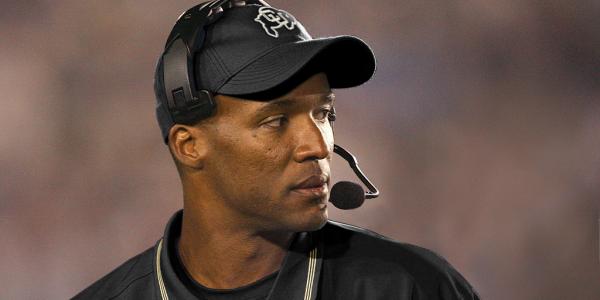The NCAA Board of Governors this week supported rule changes that would open the door for student-athletes to receive compensation for their name, image and likeness beginning in the 2021-22 academic year.
At its April 28 meeting, the board directed all three divisions of the NCAA to consider appropriate rule changes based on recommendations from its Federal and State Legislation Working Group, which had presented a comprehensive report to the board. CU Boulder Chancellor Philip DiStefano is a member of the board, while Athletic Director Rick George is a member of the working group.
The recommendations now move on to the rule-making structure in each of the three divisions for further consideration. The divisions are expected to adopt new name, image and likeness rules by January 2021. DiStefano sits on the Division I Board of Directors, in addition to the NCAA Board of Governors, and George is a member of the Division I Council.
“I enjoyed being part of the working group process, and am excited that the board of governors supported the recommendations in the report so that we can keep moving this important work forward,” George said. “There’s still a lot of work to be done by the divisions to draft legislation and flesh out the details of this framework, and I anticipate we’re on track to meet the January 2021 timeline.”
Rule changes supported by the board include allowing student-athletes to receive compensation for third-party endorsements, both related to and separate from athletics. The board also supported compensation for other student-athlete opportunities, such as social media, businesses they have started and personal appearances within the guiding principles originally outlined by the board in October.
While student-athletes would be permitted to identify themselves by sport and school, the use of conference and school logos, trademarks or other involvement would not be allowed. The board emphasized that at no point should a university or college pay student-athletes for name, image and likeness activities.
The board is requiring guardrails around any future name, image and likeness activities. These guardrails would include no name, image and likeness activities that would be considered pay for play; no school or conference involvement; no use of name, image and likeness for recruiting by schools or boosters; and the regulation of agents and advisors.
“The working group should be commended for their efforts in making recommendations that would modernize our rules around name, image and likeness in support of our student-athletes and do so in a way that upholds the NCAA’s mission,” DiStefano said.
In other NCAA legislative news from the NCAA Board of Governors, Division I Board of Directors and Division I Council over the past week:
- The NCAA Board of Governors expanded its existing association-wide campus sexual-violence policy as it relates to the disclosure of student-athlete conduct that has resulted in an investigation, discipline through a Title IX proceeding or a criminal proceeding for sexual, interpersonal or other acts of violence.
- The Division I Board of Directors and Division I Presidential Forum discussed how to best support schools, student-athletes and incoming student-athletes in the wake of the COVID-19 pandemic. Both groups discussed several membership requirements and other legislative obligations with the goal of identifying which requirements speak to core values of the division and which might be less vital. Ultimately, the groups decided that requirements that support student-athletes and opportunities for participation are the most important.
- The board and forum also discussed requests from the majority of Division I conferences to consider providing all Division I members blanket waivers of several legislative and membership requirements. The letters asked for the blanket waivers for a period of two to four years to allow schools to recover from the impact of the COVID-19 pandemic. Both the board and forum endorsed a set of principles to guide the division’s discussion of the requests, including that given the impact of the COVID-19 pandemic, examining areas of potential flexibility was appropriate while continuing to preserve opportunities for student-athletes.
- The groups also received an update from the Transfer Waiver Working Group. This group, appointed by the board last fall, is charged with studying potential changes to the waiver process. Waiver guidelines can be changed at any time, and this group has recommended that waiver guidelines allow the opportunity for a one-time transfer waiver for student-athletes in the five sports not legislatively allowed to transfer and compete immediately: men’s basketball, women’s basketball, baseball, men’s ice hockey and football. The waiver criteria would mirror the legislative opportunity for student-athletes in other sports. The Division I Council could vote on the guideline changes as early as May.



